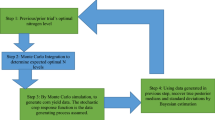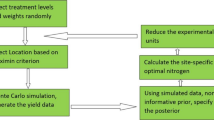Abstract
The goal of this research was to create an agricultural adaptive management framework that enables the probabilistic optimization of N fertilizer to achieve maximized net returns under multiple uncertainties. These uncertainties come in the form of bioclimatic variables that drive crop yield, and economic variables that determine profitability. Taking advantage of variable rate application (VRA), spatial monitoring technologies, and historical datasets, we demonstrate a comprehensive spatiotemporal modeling approach that can achieve optimal efficiency for the producer under such uncertainties. The utility of VRA fertilizer research for producers is dependent upon a localized accurate understanding of crop responses under a range of possible climatic regimes. We propose an optimization framework that continuously updates by integrating annual on-site experiments, VRA prescriptions, crop prices received, input prices, and climatic conditions observed each year under a dryland spring wheat (Triticum aestivum) cropping system. The spatio-temporal Bayesian framework used to assimilate these data sources also enables calculation of the probabilities of economic returns and the risks associated with different VRA strategies. The results from our simulation experiments indicated that our framework can successfully arrive at optimum N management within 6–8 years using sequential Bayesian analysis, given complete uncertainty in water as a driver of crop yield. Once optimized, the spatial N management approach increased net returns by $23–25 ha−1 over that of uniform N management. By identifying small-scale targeted treatments that can be merged with VRA prescriptions, our framework ensures continuous reductions in parameter uncertainty. Thus we have demonstrated a useful decision aid framework that can empower agricultural producers with site-specific management that fully accounts for the range of possible conditions farmers must face.










Similar content being viewed by others
References
Anselin, L., Bongiovanni, R., & Lowenberg-DeBoer, J. (2004). A spatial econometric approach to the economics of site-specific nitrogen management in corn production. American Journal of Agricultural Economics, 86(3), 675–687.
Archontoulis, S. V., & Miguez, F. E. (2013). Nonlinear regression models and applications in agricultural research. Agronomy Journal. doi:10.2134/agronj2012.0506 .
Baxter, S. J., Oliver, M. A., & Gaunt, J. (2003). A geostatistical analysis of the spatial variation of soil mineral nitrogen and potentially available nitrogen within an arable field. Precision Agriculture, 4(2), 213–226.
Besag, J. (1974). Spatial interaction and the statistical analysis of lattice systems. Journal of the Royal Statistical Society. Series B (Methodological). 36(2), 192-236.
Besag, J., York, J., & Mollie, A. (1991). Bayesian image restoration, with two applications in spatial statistics. Annals of the Institute of Statistical Mathematics, 43(1), 1–59.
Biermacher, J. T., Brorsen, B. W., Epplin, F. M., Solie, J. B., & Raun, W. R. (2009). The economic potential of precision nitrogen application with wheat based on plant sensing. Agricultural Economics, 40(4), 397–407. doi:10.1111/j.1574-0862.2009.00387.x.
Bongiovanni, R. G., Robledo, C. W., & Lambert, D. M. (2007). Economics of site-specific nitrogen management for protein content in wheat. Computers and Electronics in Agriculture, 58(1), 13–24. doi:10.1016/j.compag.2007.01.018.
Brevik, E. C., Fenton, T. E., & Lazari, A. (2006). Soil electrical conductivity as a function of soil water content and implications for soil mapping. Precision Agriculture, 7(6), 393–404. doi:10.1007/s11119-006-9021-x.
Cambardella, C. A., & Karlen, D. L. (1999). Spatial analysis of soil fertility parameters. Precision Agriculture, 1(1), 5–14.
Corwin, D. L., & Lesch, S. M. (2003). Application of soil electrical conductivity to precision agriculture. Agronomy Journal, 95(3), 455–471.
Corwin, D. L., & Lesch, S. M. (2005). Apparent soil electrical conductivity measurements in agriculture. Computers and Electronics in Agriculture, 46(1–3), 11–43. doi:10.1016/j.compag.2004.10.005.
Cressie, N., & Wikle, C. K. (2011). Statistics for Spatio-Temporal Data. Hoboken: John Wiley & Sons Inc.
Florin, M. J., McBratney, A. B., & Whelan, B. M. (2009). Quantification and comparison of wheat yield variation across space and time. European Journal of Agronomy, 30(3), 212–219. doi:10.1016/j.eja.2008.10.003.
Florin, M. J., McBratney, A. B., Whelan, B. M., & Minasny, B. (2010). Inverse meta-modelling to estimate soil available water capacity at high spatial resolution across a farm. Precision Agriculture, 12(3), 421–438. doi:10.1007/s11119-010-9184-3.
Fonnesbeck, C., Patil, A., Huard, D., & Salvatier, J. (2012). PyMC. Retrieved June 6, 2013, from http://github.com/pymc-devs/pymc.
Gelman, A., Carlin, J. B., Stern, H. S., & Rubin, D. B. (2004). Bayesian Data Analysis (2nd ed). New York, NY: Chapman & Hall/CRC.
Jackson, G. (1998). Predicting Spring Wheat Yield and Protein Response to Nitrogen. MSU Fertilizer Facts, no. 17. Retrieved August 10, 2013 from http://www.sarc.montana.edu/php/Research/ffacts/?id=17
Jiang, P., He, Z., Kitchen, N. R., & Sudduth, K. A. (2009). Bayesian analysis of within-field variability of corn yield using a spatial hierarchical model. Precision Agriculture, 10(2), 111–127. doi:10.1007/s11119-008-9070-4.
Jung, W. K., Kitchen, N. R., Sudduth, K. A., Kremer, R. J., & Motavalli, P. P. (2005). Relationship of apparent soil electrical conductivity to claypan soil properties. Soil Science Society of America Journal, 69(3), 883–892.
Kerry, R., & Oliver, M. A. (2003). Variograms of ancillary data to aid sampling for soil surveys. Precision Agriculture, 4(3), 261–278.
Khosla, R., Inman, D., Westfall, D. G., Reich, R. M., Frasier, M., Mzuku, M., Koch.B. and Hornung.A. (2008). A synthesis of multi-disciplinary research in precision agriculture: site-specific management zones in the semi-arid western Great Plains of the USA. Precision Agriculture, 9(1–2), 85–100. doi:10.1007/s11119-008-9057-1.
King, J. A., Dampney, P. M. R., Lark, R. M., Wheeler, H. C., Bradley, R. I., & Mayr, T. R. (2005). Mapping potential crop management zones within fields: use of yield-map series and patterns of soil physical properties identified by electromagnetic induction sensing. Precision Agriculture, 6(2), 167–181.
Koch, B., Khosla, R., Frasier, W. M., Westfall, D. G., & Inman, D. (2004). Economic feasibility of variable-rate nitrogen application utilizing site-specific management zones. Agronomy Journal, 96(6), 1572–1580.
Kravchenko, A. N., Robertson, G. P., Thelen, K. D., & Harwood, R. R. (2005). Management, topographical, and weather effects on spatial variability of crop grain yields. Agronomy Journal, 97(2), 514–523.
Kühn, J., Brenning, A., Wehrhan, M., Koszinski, S., & Sommer, M. (2008). Interpretation of electrical conductivity patterns by soil properties and geological maps for precision agriculture. Precision Agriculture, 10(6), 490–507. doi:10.1007/s11119-008-9103-z.
Laird, N. M., & Ware, J. H. (1982). Random effects models for longitudinal data. Biometrics, 38, 963–974.
Lambert, D. M., Lowenberg-DeBoer, J., & Malzer, G. L. (2006). Economic analysis of spatial-temporal patterns in corn and soybean response to nitrogen and phosphorus. Agronomy Journal, 98(1), 43. doi:10.2134/agronj2005.0005.
Lichstein, J. W., Simons, T. R., Shriner, S. A., & Franzreb, K. E. (2002). Spatial autocorrelation and autoregressive models in ecology. Ecological Monographs, 72(3), 445–463.
Liu, Y., Swinton, S. M., & Miller, N. R. (2006). Is site-specific yield response consistent over time? Does it pay? American Journal of Agricultural Economics, 88(2), 471–483.
Mamo, M., Malzer, G. L., Mulla, D. J., Huggins, D. R., & Strock, J. (2003). Spatial and temporal variation in economically optimum nitrogen rate for corn. Agronomy Journal, 95(4), 958–964.
Meyer-Aurich, A., Weersink, A., Gandorfer, M., & Wagner, P. (2010). Optimal site-specific fertilization and harvesting strategies with respect to crop yield and quality response to nitrogen. Agricultural Systems, 103(7), 478–485. doi:10.1016/j.agsy.2010.05.001.
Montana Wheat and Barley Committee. (2013). Pricing: Montana Wheat & Barley Committee. Retrieved April 4, 2013, from http://wbc.agr.mt.gov/wbc/Producers/Pricing/local/2013_GreatFalls.xls.
National Climatic Data Center. (2013). NCDC: Precipitation Data. Retrieved March 3, 2013, from http://gis.ncdc.noaa.gov/map/viewer/#app=cdo&cfg=cdo&theme=precip&layers=000111.
Patzold, S., Mertens, F. M., Bornemann, L., Koleczek, B., Franke, J., Feilhauer, H., et al. (2008). Soil heterogeneity at the field scale: a challenge for precision crop protection. Precision Agriculture, 9(6), 367–390. doi:10.1007/s11119-008-9077-x.
R Core Team. (2012). R: A Language and Environment for Statistical Computing. Vienna, Austria: R Foundation for Statistical Computing. Retrieved from http://www.R-project.org/.
Robinson, G. K. (1991). That BLUP is a good thing: the estimation of random effects. Statistical Science, 6(1), 15–32.
Sadler, E. J., Sudduth, K. A., & Jones, J. W. (2007). Separating spatial and temporal sources of variation for model testing in precision agriculture. Precision Agriculture, 8(6), 297–310. doi:10.1007/s11119-007-9046-9.
Schlather, M. (2012). RandomFields: Simulation and Analysis of Random Fields. Retrieved November 6, 2012, from http://CRAN.R-project.org/package=RandomFields.
Shahandeh, H., Wright, A. L., & Hons, F. M. (2010). Use of soil nitrogen parameters and texture for spatially-variable nitrogen fertilization. Precision Agriculture, 12(1), 146–163. doi:10.1007/s11119-010-9163-8.
Shahandeh, H., Wright, A. L., Hons, F. M., & Lascano, R. J. (2005). Spatial and temporal variation of soil nitrogen parameters related to soil texture and corn yield. Agronomy Journal, 97(3), 772. doi:10.2134/agronj2004.0287.
Thöle, H., Richter, C., & Ehlert, D. (2013). Strategy of statistical model selection for precision farming on-farm experiments. Precision Agriculture. doi:10.1007/s11119-013-9306-9.
Thrikawala, S., Weersink, A., Fox, G., & Kachanoski, G. (1999). Economic feasibility of variable-rate technology for nitrogen on corn. American Journal of Agricultural Economics, 81(4), 914–927.
USDA ERS. (2012). Commodity Costs and Returns. Retrieved April 7, 2013, from http://www.ers.usda.gov/datafiles/Commodity_Costs_and_Returns/Data/Current_Costs_and_Returns_All_commodities/cwhea.xls.
USDA ERS. (2012). Fertilizer Price Indexes, 1960-2012. Retrieved April 7, 2013, from http://www.ers.usda.gov/datafiles/Fertilizer_Use_and_Price/Fertilizer_Prices/table7.xls.
Acknowledgments
This material is based on work supported by the Montana Institute on Ecosystems’ award from the National Science Foundation EPSCoR Track-1 Program under Grant #EPS-1101342 (INSTEP 3). Any opinions, findings and conclusions or recommendations expressed in this material are those of the author(s) and do not necessarily reflect the views of the National Science Foundation. This work is also supported by the Montana Fertilizer Advisory Committee and graduate student Grant GW12-004 from the Western Sustainable Agriculture Research and Education Program.
Author information
Authors and Affiliations
Corresponding author
Rights and permissions
About this article
Cite this article
Lawrence, P.G., Rew, L.J. & Maxwell, B.D. A probabilistic Bayesian framework for progressively updating site-specific recommendations. Precision Agric 16, 275–296 (2015). https://doi.org/10.1007/s11119-014-9375-4
Published:
Issue Date:
DOI: https://doi.org/10.1007/s11119-014-9375-4




